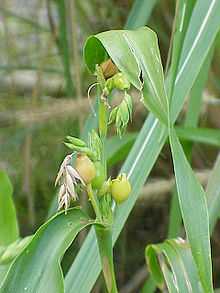Job's Tears
| Job's tears beads | |
|---|---|
 | |
| Scientific classification | |
| Kingdom: | Plantae |
| (unranked): | Angiosperms |
| (unranked): | Monocots |
| (unranked): | Commelinids |
| Order: | Poales |
| Family: | Poaceae |
| Subfamily: | Panicoideae |
| Tribe: | Andropogoneae |
| Genus: | Coix |
| Species: | C. lacryma-jobi |
| Binomial name | |
| Coix lacryma-jobi L. | |
| Synonyms | |
|
Coix agrestis Lour. | |

Job's tears (US) or Job's-tears (UK),[1] scientific name Coix lacryma-jobi, also known as coixseed, tear grass, hato mugi, adlay or adlai, is a tall grain-bearing tropical plant of the family Poaceae (grass family) native to Southeast Asia[2] but elsewhere cultivated in gardens as an annual. It has been naturalized in the southern United States and the New World tropics. In its native environment it is grown in higher areas where rice and corn do not grow well. Job's tears are also commonly sold as Chinese pearl barley in Asian supermarkets, although C. lacryma-jobi is not closely related to barley (Hordeum vulgare).
There are two main varieties of the species:
- The wild variety Coix lacryma-jobi var. lacryma-jobi has hard-shelled pseudocarps which are very hard, pearly white, oval structures used as beads for making rosaries, necklaces, and other objects.
- The cultivated variety Coix lacryma-jobi var. ma-yuen is harvested as a cereal crop, has a soft shell, and is used medicinally in parts of Asia.[3]
Taxonomy
The species was named by Carl Linnaeus in 1753. As of February 2015, four varieties are accepted by the World Checklist of Selected Plant Families:[4]
- Coix lacryma-jobi var. lacryma-jobi. Widely distributed throughout the Asian subcontinent to peninsular Malaysia and Taiwan; naturalized elsewhere.
- Coix lacryma-jobi var. ma-yuen (Rom.Caill.) Stapf. South China to peninsular Malaysia and the Philippines.
- Coix lacryma-jobi var. puellarum (Balansa) A.Camus. Assam to Yunnan (China) and Indochina.
- Coix lacryma-jobi var. stenocarpa Oliv.. Eastern Himalayas to Indochina.
Uses
Besides the use for ornamental purposes, Job's tears grains are useful as a source of food (cereals) and folk medicine.[5][6]
Throughout East Asia, Vyjanti beads are available in dried form and cooked as a grain. The grains are generally spherical, with a groove on one end, and polished white in color, though in Japan unpolished yuuki hatomugi, which is unpolished and brown in color, is also available.
In Korea, a thick drink called yulmu cha (율무차, literally "Job's tears tea") is made from powdered Job's tears. A similar drink, called Yi Ren Jiang (薏仁漿), also appears in Chinese cuisine, and is made by simmering whole polished Job's Tears in water and sweetening the resulting thin, cloudy liquid with sugar. The grains are usually strained from the liquid but may also be consumed separately or together.
In both Korea and China, distilled liquors are also made from the grain. One such example is the South Korean liquor called okroju (옥로주; hanja: 玉露酒), which is made from rice and Job's tears. In Japan, an aged vinegar is made from the grain.[7]
In southern Vietnam, a sweet, cold soup called sâm bổ lượng has Job's Tears as one of its ingredients. This dish derives from the southern Chinese tong sui called qīng bǔ liáng (清補涼; Cantonese: ching1 bou2 leung4).
In Thailand, it is often consumed in teas and other drinks, such as soy milk.
It is also used alongside other herbs in traditional Chinese medicine. Particularly Coix lacryma-jobi var. ma-yuen has been used in the traditional Chinese medicine to invigorate the spleen function and promote urination, alleviate arthritis, arrest diarrhea, remove heat and facilitate the drainage of pus.[8]
In both the Eastern Band of Cherokee Indians and the Cherokee Nation in Oklahoma, the beads of Job's Tears are called "corn beads" or "Cherokee corn beads" and have been used for personal adornment since at least the time of the united Cherokee Republic. A common folk story is that the corn beads sprang up along the path during the 1838 forced march of many Cherokees to Oklahoma from their southeastern North American homelands by the U.S. military.
References
- ↑ "BSBI List 2007" (xls). Botanical Society of Britain and Ireland. Archived from the original on 2015-02-25. Retrieved 2014-10-17.
- ↑ Taylor, G. D., "Some crop distributions by tribes in upland Southeast Asia", Southwestern Journal of Anthropology Vol. 9, No. 3, Autumn 1953
- ↑ Arora, R. K., 1977, "Job's tears (Coix lacryma-jobi) - a minor food and fodder crop of northeastern India", Economic Botany, Vol. 31, No. 3, 358–366.
- ↑ "Search for Coix lacryma-jobi". World Checklist of Selected Plant Families. Royal Botanic Gardens, Kew. Retrieved 2015-02-01.
- ↑ Hill,A.F.,1952,Economic Botany,McGraw-Hill
- ↑ Duke,J.A.,1983,Handbook of Energy Crops,http://www.hort.purdue.edu/newcrop/duke_energy/Coix_lacryma-jobi.html
- ↑ "Traditional Japanese foods - Hato Mugi Vinegar". Natural Import Company. Retrieved 2012-01-10.
- ↑ Wang L, Waltenberger B, Pferschy-Wenzig EM, Blunder M, Liu X, Malainer C, Blazevic T, Schwaiger S, Rollinger JM, Heiss EH, Schuster D, Kopp B, Bauer R, Stuppner H, Dirsch VM, Atanasov AG. Natural product agonists of peroxisome proliferator-activated receptor gamma (PPARγ): a review. Biochem Pharmacol. 2014 Jul 29. pii: S0006-2952(14)00424-9. doi: 10.1016/j.bcp.2014.07.018. PubMed PMID 25083916.
Further reading
- Flora of China, Vol. 22, pp. 648–649, Online
- James A. Duke: Handbook of Energy Crops, 1983.
- Pink, A. (2004). Gardening for the Million. Project Gutenberg Literary Archive Foundation.
- Taylor, G. (1953). "Some Crop Distributions by Tribes in Upland Southeast Asia; Southwestern Journal of Anthropology, Vol. 9, No. 3". Southwestern Journal of Anthropology (University of New Mexico) 9 (3): 296–308. JSTOR 3628701.
External links
| Wikispecies has information related to: Coix lacryma-jobi |
| Wikimedia Commons has media related to Coix lacryma-jobi. |
| ||||||||||||||||||||||||||||||||||||||||||||||||||||